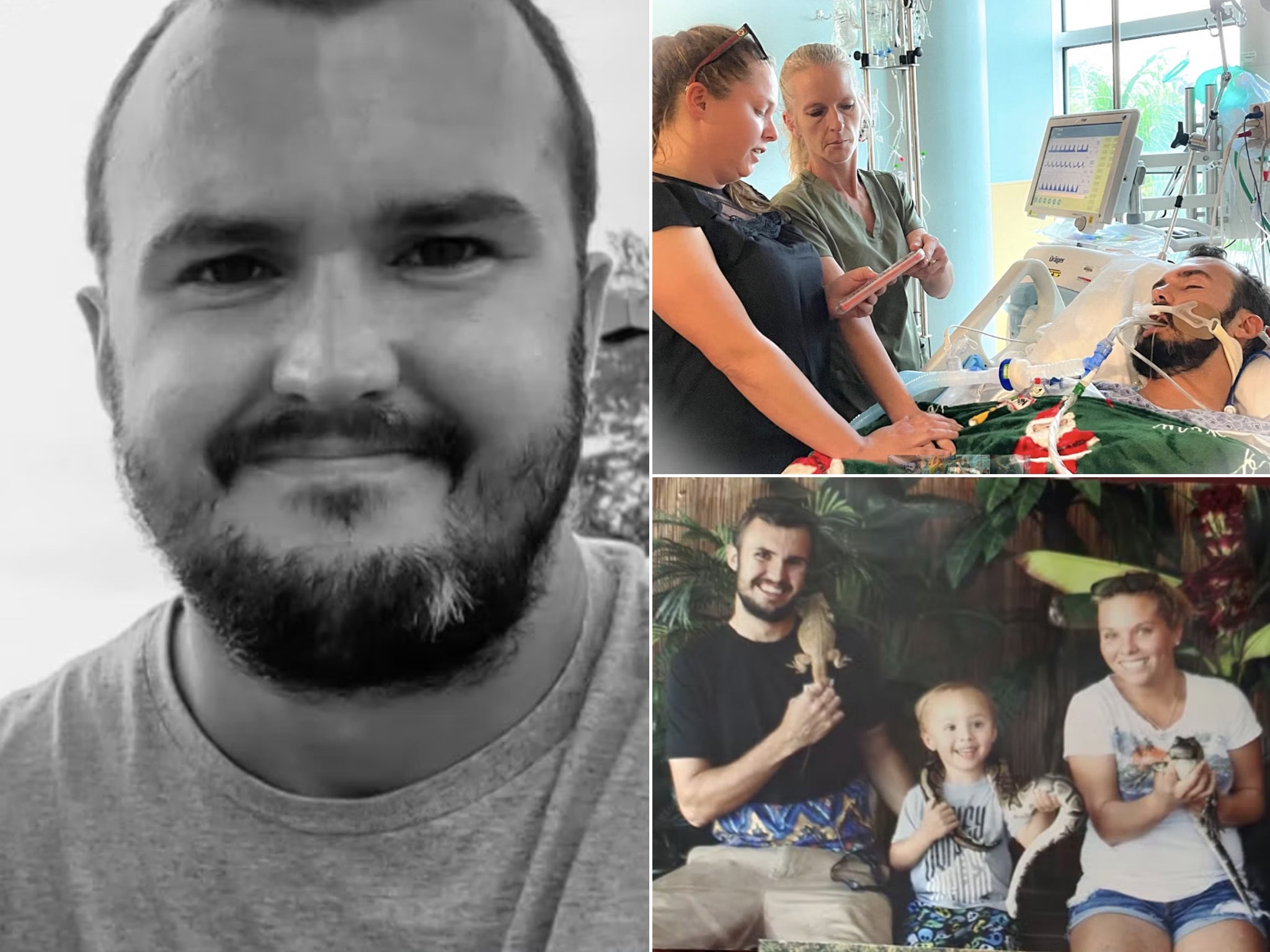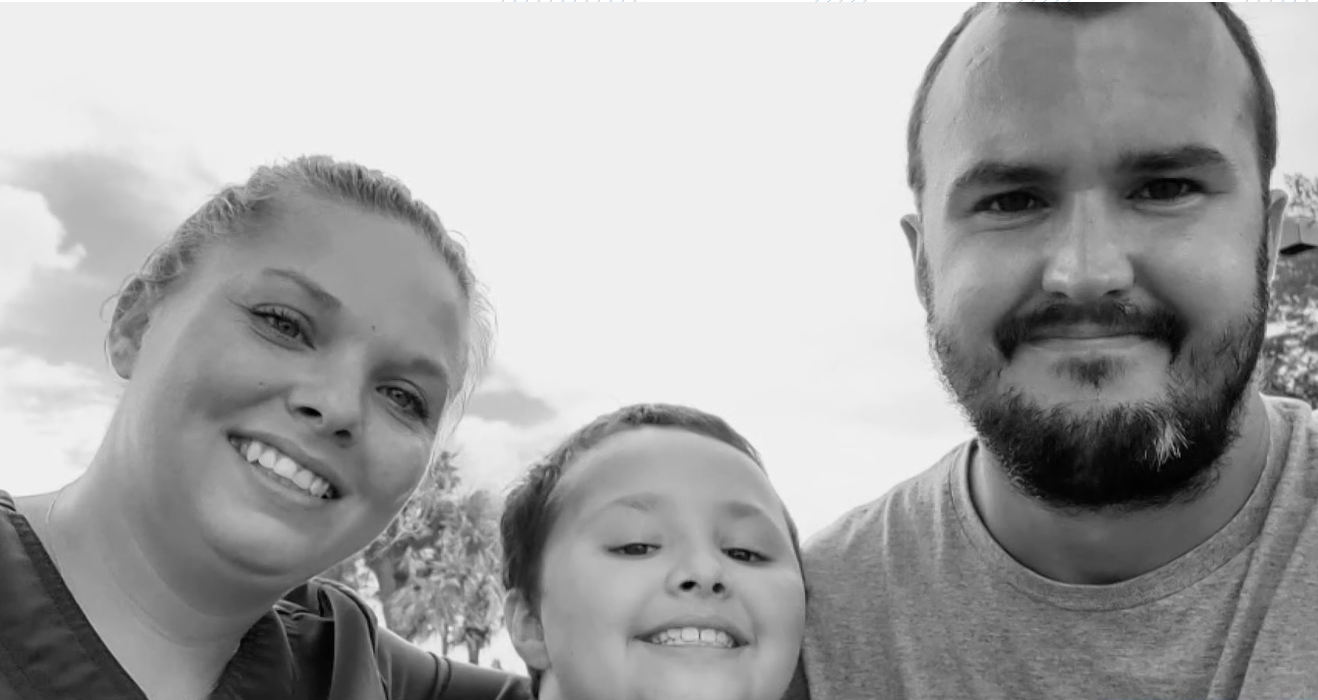Her healthy husband died aged 26. The silent killer was in their home
Toxic black mould began growing in Christian Childers and Kendra Elliott’s Florida home in the days after Hurricane Ian. Despite pleas for help, Childers suffered a fatal asthma attack months later. An expert tells Bevan Hurley that authorities are ignoring the dangers of this ‘silent killer’


Your support helps us to tell the story
From reproductive rights to climate change to Big Tech, The Independent is on the ground when the story is developing. Whether it's investigating the financials of Elon Musk's pro-Trump PAC or producing our latest documentary, 'The A Word', which shines a light on the American women fighting for reproductive rights, we know how important it is to parse out the facts from the messaging.
At such a critical moment in US history, we need reporters on the ground. Your donation allows us to keep sending journalists to speak to both sides of the story.
The Independent is trusted by Americans across the entire political spectrum. And unlike many other quality news outlets, we choose not to lock Americans out of our reporting and analysis with paywalls. We believe quality journalism should be available to everyone, paid for by those who can afford it.
Your support makes all the difference.When Hurricane Ian swept through Florida in September, Christian Childers and Kendra Elliott’s home on the central Gulf Coast town of Englewood became swamped under five inches of water.
The water subsided a few days later, and then the toxic mould began to grow “dramatically” on walls, ceilings and air vents in the couple’s rented bungalow, Ms Elliott told The Independent.
With thousands displaced and no emergency housing available, the blended family of six were forced to board up a bedroom and bathroom where the mould was at its worst and wait for help.
In the ensuing weeks, Childers experienced fatigue and shortness of breath, and suffered two asthma attacks that required hospitalisation, Ms Elliott said.
On Christmas Eve he suffered a third serious asthma attack and was rushed to Sarasota Memorial Hospital where he died on 2 January.
“It’s like a nightmare,” Ms Elliott told The Independent. “They told us the house was still liveable. Well clearly it wasn’t liveable because he died. They forced us to live in a death trap.”
‘Nothing got fixed’
Englewood, which straddles Charlotte and Sarasota Counties, was especially hard hit by Hurricane Ian. In Charlotte County alone, dozens of residents were reported dead or missing in the Category 4 storm’s aftermath among a population of about 190,000.
With many streets blocked and electricity down, the Federal Emergency Management Agency’s emergency response teams prioritised helping survivors whose houses had been torn down or badly damaged.

Ms Elliott told The Independent the family’s appeals for help to clean and detoxify their home to FEMA and the Red Cross went unanswered.
“If your roof is intact, it’s deemed a liveable structure,” she said.
The electricity remained down for more than two weeks, and the pipes had burst.
Simple tasks like clothing or cooking meals for their two sons, nine-year-old Riley and four-year-old Colton, became an ordeal.
Ms Elliott was also caring for her sister’s seven-year-od son Charles and her mother, who had undergone surgery a year earlier. She had left her job to care for the relatives and the family were behind on bills.
Their landlord called in a handyman to carry out much-needed repairs. While looking for the source of the mould, he busted open an inner wall — and more of the toxic sludge came pouring back out.
“Nothing got fixed,” Ms Elliott said. “They didn’t even come back and put drywall over it.”
Childers was the sole breadwinner in the household, and in the months after the hurricane, he continued to travel around the state for work.
Every time he came home, his asthma got worse.

He suffered two attacks in the weeks leading up to Christmas that required trips to the emergency room.
On the second time, his oxygen levels were so low that he had to spend three nights in hospital.
Ms Elliott said they again approached FEMA and the Red Cross for emergency housing, but were told none was available.
Then on Christmas Eve, Childers was struggling to breathe, and she immediately put him in the car and drove to his parent’s home for help.
While heading to hospital, Chiders’ condition deteriorated and they pulled into a fire station, where he suffered a cardiac arrest.
EMTs worked on him for an hour to get his heart beating again, and then raced him to Sarasota Memorial Hospital.

Doctors told Ms Elliott that her fiancee had suffered a hypoxic brain issue due to a lack of oxygen. Childers was placed in a medically induced coma, but never regained consciousness and died on 2 January, surrounded by family.
The landlord served the family with an eviction notice while Childers was in hospital.
Ms Elliott moved in to a spare room at her friend Lorie Peterson’s home, and they are appealing for help to raise enough money for her to get her own place.
Ms Peterson told The Independent that the $18,000 already raised through a GoFundMe would go towards purchasing a mobile home for them to live in.

The cost of housing has exploded since the pandemic, she says.
A modest three-bedroom home near her Englewood neighbourhood is available for $3600 per month on Zillow.
Plus, Ms Elliott says a toxicity report on their former house found that the “numbers were through the roof”, and she’s concerned for her son’s health.
She now faces a $5,000 medical bill to test whether her boys have suffered any adverse reaction from the mould.
Ms Elliott said she had been feeling lethargic and out of sorts, and fears it could be due to the effects of the toxic mould.
They have been contacting local lawmakers, and Unite Florida, a flood-relief organisation, to assess their options.
Ms Elliott said the federal and state response to Hurricane Ian had let them down.
“People are dying from a failed policy. Something needs to be done.”

In a statement to The Independent, a FEMA spokesperson expressed their condolences to Childers’ family.
“Every death is a tragedy, and we are deeply saddened that another life has been cut short in the wake of Hurricane Ian.”
The FEMA spokesperson said the agency had recently provided an additional $119m to clean and sanitise nearly 400,000 homes in Florida, part of a $863m funding package to repair homes.
They said the agency is committed to providing survivors of natural disasters with the tools they need to clean and sanitise their homes after a disaster.
‘A silent killer’
Dr Anindya Chanda has studied the effects of toxic fungal pathogens for 20 years, and says the danger presented by mould is under-reported and widely misunderstood.
The chief executive of the Virginia-based biotech start-up Mycologics told The Independent that mould exposure can weaken the immune system and make patients more vulnerable to other infectious diseases.
It has been linked to liver cancer, bleeding in the lungs, along with setting off allergies and asthma attacks.
But because it requires specific blood or urine testing to identify, it’s often overlooked, he said.
According to the Centers for Disease Control and Prevention, studies have been inconclusive on whether toxic mould is to blame for many of the health conditions it has been linked to.
But Dr Chanda believes that is due to a lack of research and funding in the area.
After Hurricane Katrina in 2005, studies showed an increase in the prevalence of asthma where mould had been growing, Dr Chanda said.
And when historic flooding hit South Carolina in 2015, thousands of college students reported that mould had triggered asthma attacks and allergies, according to an investigation by the Post and Courier.
“I call it a silent killer, because it is so hard to diagnose,” he told The Independent in an interview.
“If you are breathing these spores and your immune system has been substantially weakened, it also affects your mental health,” he said.
“It has a lot of other impacts on your overall quality of life.”
Dr Chanda said despite the rising number of reported cases, no records exist to show how many Americans fall ill from breathing the spores.
This is in part due to the difficulty in establishing causualty between a fungal exposure and a disease.
How to keep the home safe from mould
Black, or toxic, mould is sometimes referred to as stachybotrys chartarum.
The fungus has a distinctive musty smell and is most commonly found in wallpaper and drywall in damp or water-damaged buildings.
Mould is usually caused by excess moisture in the home, and can be especially prevalent after natural disasters such as hurricanes and flooding.
The CDC recommends that anyone who has asthma or is immune-compromised should avoid a mouldy home, even while it is being cleaned.
Even otherwise healthy people can suffer shortness of breath, coughing or wheezing after being exposed to mould, it says.
The CDC recommends sealing off mouldy areas with tarp, and changing clothing and shoes after being in mouldy rooms.
Should survivors of natural disasters have to remain in a mouldy house, the CDC recommends spending as much time outside as possible.
Under normal circumstances, the risk of mould can be reduced by using a dehumidifier, promptly fixing leaky roofs, windows, and pipes, and ventilating shower, laundry, and cooking areas.



Join our commenting forum
Join thought-provoking conversations, follow other Independent readers and see their replies
Comments